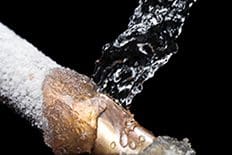Every winter, plummeting temperatures bring ice and snow to most regions of the country and present us with a unique set of loss prevention challenges. A common, yet significant winter challenge is how to prevent interior water pipes from freezing.
Nearly all commercial buildings have automatic sprinkler systems in place to protect against fire. While a fire can cause monumental loss, so can its polar opposite: ice.

A freeze-up of automatic sprinkler system pipes, caused by insufficient building heat, may result in burst piping and subsequent water damage to a building and its contents. If a fire occurred while the sprinkler system was incapacitated, the resulting loss could be catastrophic.
To prevent sprinkler system pipes from freezing, these standard building management procedures should be followed:
- Prior to the official start of winter, the building’s heating system should be completely serviced and then checked on a regular basis throughout the cold weather months.
- The structural components of the building should be inspected for any deficiencies or problem areas. Broken windows and wall cracks should be repaired promptly to prevent drafts from entering the building.
- Temperatures in areas protected by wet pipe systems should be kept above 40°F.
- Adequate heat should be provided to concealed areas, such as attics and areas above ceilings, where sprinkler piping has been installed.
- Although dry pipe systems are less susceptible to freeze-ups, they should also be included in any winterizing program.
- Fire pumps should be in a heated room and should be tested at periodic intervals. Suction taken from open water should have lines that are buried below the frost level. Intake screens should be kept clear of ice.
- Gravity tanks should be checked for leaks and overflows. Should leaking or overflowing water freeze, it could cause structural damage to, and the subsequent collapse of, the tank.
- Fire hydrants and valves should be kept clear of snow and ice to prevent freezing. Piping
for outdoor systems should be buried below the frost level to prevent freezing. Piping that is exposed to freezing temperatures should either be insulated or heated. Fire hydrants should be checked for adequate drainage and post indicator valves should be checked for leakage. - Once winter has arrived, management should keep a close watch on weather conditions. All commercial buildings and facilities should have a plan in place for handling extreme snowfalls and extreme cold spells that may lead to heating problems.
- Supervisory personnel should be provided with a list of emergency numbers to call in case of trouble.
Despite following all of the recommended procedures, a freeze-up may still occur. If that happens, management should contact the experts for repair, rather than attempt to make repairs in a “do-it-yourself” manner.
While the sprinkler system is down, special emphasis should be immediately placed on controlling ignition sources and securing known fire hazard areas throughout the facility:
- Cutting and welding operations should be postponed until repairs have been completed.
- Smoking should be prohibited throughout the unprotected area.
- Supplies of flammable and combustible materials should be kept to a minimum.
- A temporary water line should be supplied to provide water to the unprotected area.
- If possible, a staff person should be posted to monitor the area while repairs are being made.
In summary, by implementing preventive measures, emphasizing prompt, efficient repairs, and controlling known fire hazards, building managers can decrease the likelihood of frozen, incapacitated sprinkler systems and minimize the potential for loss should the sprinkler system become incapacitated.
For more helpful information about Loss Control initiatives, best practices and training ideas that can help control costs, please visit the extensive Loss Control page on our website. We maintain a Loss Control library, which offers a wide array of safety training and educational materials that provide both technical guidance, as well as general safety and training resources.
Reprinted by permission: AMTrust North America
